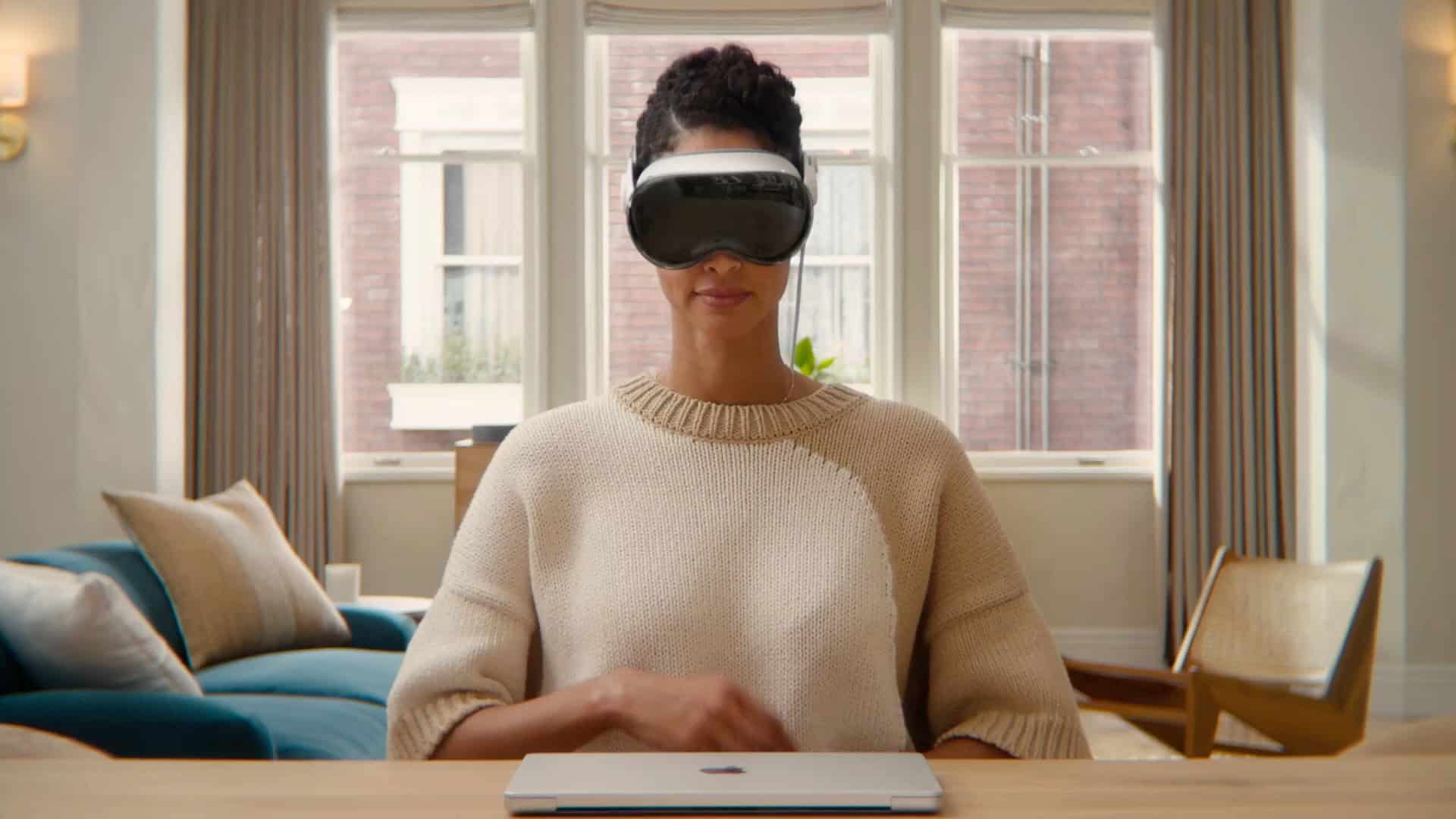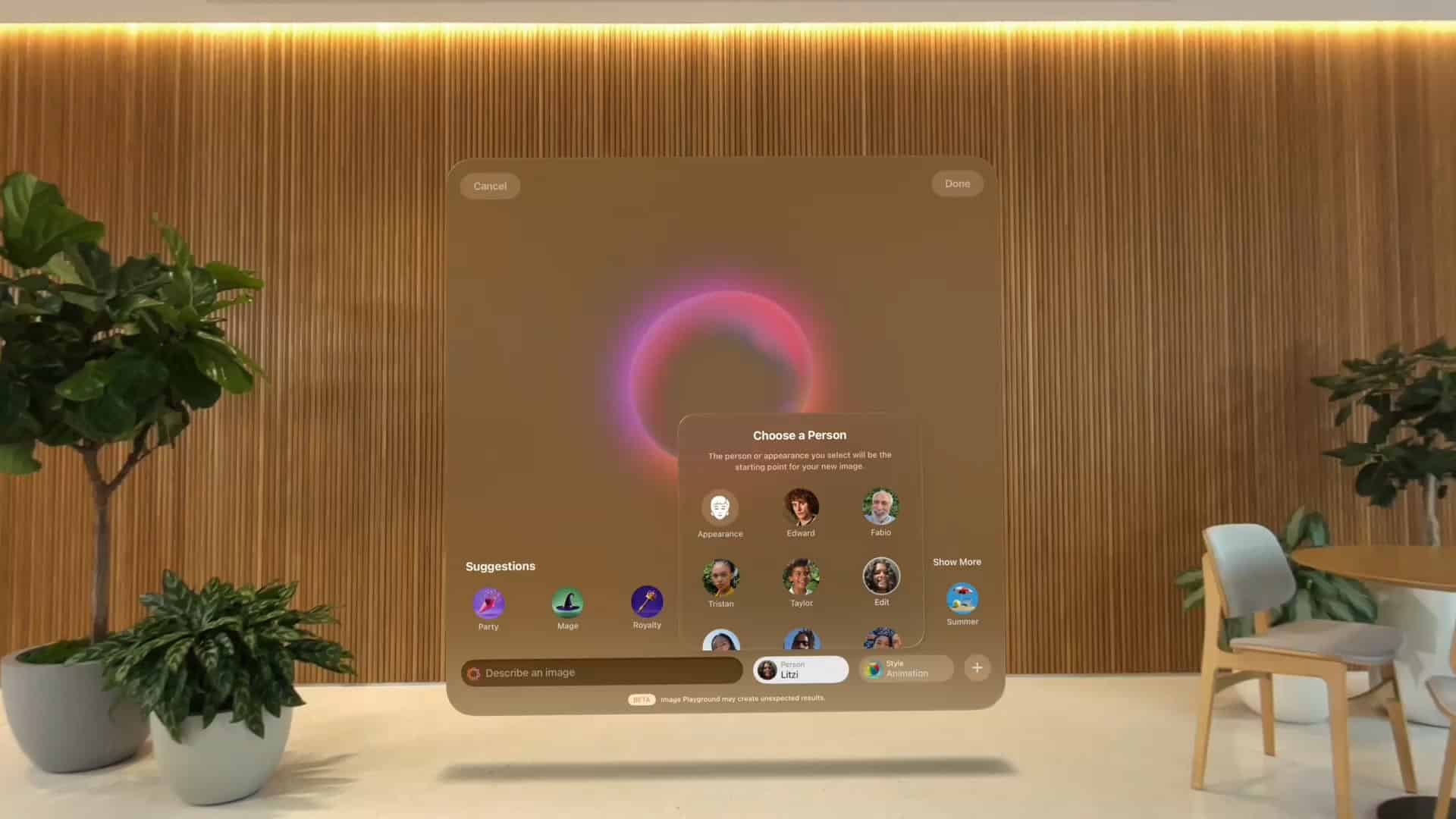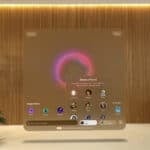Apple is rumored to be developing a “feature-packed” visionOS 3.0 update for its Vision Pro headset. Though we won’t see a new Vision Pro model in 2025 according to reports, Apple is focusing on significant software improvements instead. The upcoming visionOS 3.0 update is expected to be “a big one” according to people familiar with the matter, potentially arriving later this year or in early 2026.
Evidence shows Apple is simultaneously working on both visionOS 3.0 and visionOS 2.4, demonstrating their commitment to advancing spatial computing technology. While the company originally planned hardware updates with an M5 chip as early as late 2025, more recent information suggests 2026 is the more likely timeframe for new Vision Pro hardware.
Apple visionOS 3.0 Rumors

Apple is gearing up to unveil visionOS 3.0, a major software update for its Vision Pro mixed reality headset, at WWDC 2025. While no new hardware is expected this year, the focus is on delivering a “feature-packed” upgrade that will significantly enhance the spatial computing experience, solidifying Apple’s position at the forefront of the rapidly evolving mixed reality space.
Elevating Spatial Computing with Smarter Integration
One of the most anticipated improvements in visionOS 3.0 is the deeper integration of Apple Intelligence — the company’s advanced AI and machine learning ecosystem. This will likely translate into more intuitive interactions, smarter contextual awareness, and personalized experiences within the spatial computing environment. For example, users may see enhanced voice recognition, predictive capabilities, and seamless hand and eye tracking improvements that make navigating virtual spaces more natural and immersive.
Introducing the Spatial Gallery: A New Way to Experience Content
visionOS 3 is rumored to introduce a new Spatial Gallery app, designed to showcase immersive spatial content in ways that traditional 2D screens simply can’t match. This could revolutionize how users consume media, interact with 3D models, or collaborate in virtual workspaces. Imagine walking through a gallery of your photos, videos, or 3D objects arranged around you in a virtual space, or attending meetings where participants appear as life-size avatars in your room.
Performance, Stability, and Developer Tools
Beyond flashy new features, visionOS 3.0 will also bring critical bug fixes and performance enhancements. These improvements are vital for encouraging developers to create more sophisticated apps and experiences on the Vision Pro platform. Apple’s continued investment in developer tools and APIs will likely expand the ecosystem, helping Vision Pro evolve from a niche device into a mainstream productivity and entertainment platform.
Why No New Hardware in 2025?
Industry insiders suggest that Apple is taking a measured approach to hardware updates, focusing first on perfecting the software experience. This strategy mirrors Apple’s historical pattern of refining software to unlock the full potential of existing hardware before launching new devices. Given the complexity and novelty of spatial computing, this cautious rollout could help Apple avoid early pitfalls and deliver a more polished product to consumers.
The Bigger Picture: Apple’s Vision for Spatial Computing
visionOS 3.0 is more than just an incremental update; it represents Apple’s long-term commitment to spatial computing as a new computing paradigm. With competitors like Meta pushing aggressively in VR and mixed reality, Apple is betting on a seamless blend of the digital and physical worlds powered by intuitive software. The Vision Pro and visionOS ecosystem aim to redefine how we work, play, and connect by making spatial computing accessible, useful, and engaging.
What This Means for Consumers and Developers
For consumers, visionOS 3.0 promises richer, more immersive experiences without needing to upgrade hardware. For developers, it opens new possibilities to innovate with spatial apps that leverage AI, 3D content, and real-world context. As Apple continues to refine visionOS, the Vision Pro headset could become an essential tool for creative professionals, gamers, educators, and everyday users alike.
In summary, visionOS 3.0 is shaping up to be a pivotal update that will deepen Apple’s mixed reality capabilities and user experience. While hardware may stay the same in 2025, the software advancements could dramatically expand what Vision Pro can do — bringing us one step closer to the future of computing.
For more detailed insights and ongoing updates, stay tuned to WWDC 2025 announcements and developer previews.
Key Takeaways
- Apple is developing a major visionOS 3.0 update described as “feature-packed” by those familiar with the plans.
- Software updates may arrive before any new Vision Pro hardware, which is now expected in 2026 rather than 2025.
- Apple is advancing development on both visionOS 3.0 and visionOS 2.4 simultaneously, showing commitment to their spatial computing platform.
VisionOS 3.0 Overview
Apple’s upcoming visionOS 3.0 is reportedly a “feature-packed release” that will bring significant improvements to the Vision Pro headset. The new operating system continues Apple’s tradition of regular software updates that enhance user experience and add functionality.
Evolution of Apple’s Operating Systems
Apple has consistently evolved its operating systems to match hardware capabilities and user needs. VisionOS represents Apple’s venture into spatial computing, following the established pattern of iOS, iPadOS, and macOS updates. With visionOS 3.0, Apple appears to be accelerating development to refine the spatial computing experience.
Bloomberg’s Mark Gurman reports that Apple is planning this major update for 2025. Sources familiar with the matter described it as “a big one,” suggesting substantial improvements over previous versions.
While Apple isn’t expected to release new Vision Pro hardware in 2025, the focus on software updates shows the company’s commitment to the platform. The rapid development cycle mirrors Apple’s approach with its other operating systems, where major versions receive annual updates.
Comparison With Previous Versions
VisionOS 3.0 will build upon the foundation established by earlier versions. The original visionOS introduced spatial computing concepts, while visionOS 2 refined these features. Evidence shows Apple is working simultaneously on visionOS 2.4 and the more significant visionOS 3.0 update.
This approach parallels how Apple handles iOS and iPadOS, where minor point releases address bugs while major version numbers bring more substantial changes. Unlike iOS 18, which focuses on AI features, visionOS 3.0 will likely emphasize spatial computing capabilities unique to Vision Pro.
The update represents a significant evolution compared to previous versions, suggesting Apple has gathered enough user feedback to implement meaningful improvements. Early adopters of Vision Pro should benefit from these enhancements without needing new hardware.
Expected Features in VisionOS 3.0
Apple is reportedly planning a “feature-packed” visionOS 3.0 update that could arrive as early as this year. The update is expected to bring significant improvements to the Apple Vision Pro headset’s capabilities.
Integration with Apple Ecosystem
The upcoming visionOS 3.0 update will likely strengthen ties between Vision Pro and other Apple devices. Users may see better synchronization with their iPhones, iPads, and Macs through expanded Continuity features.
One key addition could be the integration of Apple Intelligence features already available on iOS 18.2 and iPadOS 18.2. These include Writing Tools for better text creation and editing on the headset. Users might also get access to Genmoji and Image Playground, allowing for more creative expression in spatial computing.
The update may also improve how Vision Pro interacts with other Apple services like iCloud, Apple TV+, and Apple Music. This could mean better content sharing and a more seamless experience when switching between devices in the Apple ecosystem.
Enhancements to AI and Machine Learning Capabilities
AI features will likely be a major focus in visionOS 3.0. Apple Intelligence may bring more powerful voice command capabilities and smarter spatial awareness to the Vision Pro.
A more conversational version of Siri could be included, allowing users to interact more naturally with their headset. This would make navigating the spatial interface easier and more intuitive. The AI might better understand context in conversations and perform more complex tasks.
Machine learning improvements could enhance how Vision Pro processes what users see. This might include better object recognition in mixed reality environments and smarter scene understanding. The headset could become better at predicting user needs based on past behavior.
Apple might also add new developer tools for creating AI-powered spatial apps, opening up new possibilities for third-party experiences.
User Interface and Experience Innovations
The user experience in visionOS 3.0 will likely see significant refinements. One major addition could be support for motion controllers, addressing a current limitation of the Vision Pro headset. This would make gaming and detailed manipulations much easier.
Interface improvements might include more intuitive gesture controls and faster ways to switch between apps. Apple could also introduce new multitasking features that take better advantage of the spatial environment. This might include improved window management and 3D workspace arrangements.
Eye tracking could become more precise, reducing errors and making selection more accurate. The update might also bring performance optimizations to reduce latency and improve battery life, two common concerns among current users.
Apple may introduce new spatial computing concepts that weren’t possible in earlier versions, creating experiences that truly showcase the Vision Pro’s capabilities.
Technical Specifications
VisionOS 3.0 is expected to bring significant technical improvements that will enhance both performance and user experience on Apple Vision Pro devices. These updates will address current limitations while preparing the platform for future hardware iterations.
Kernel Improvements
The core of visionOS 3.0 will likely feature substantial kernel-level optimizations to improve overall system performance. Apple is expected to focus on reducing latency in spatial tracking and rendering, which are crucial for immersive experiences. The update may introduce more efficient memory management techniques to handle complex spatial applications without draining battery life.
Developers will benefit from new APIs that provide deeper access to the spatial computing capabilities. These improvements should allow for more responsive applications and smoother transitions between different spatial environments.
The kernel enhancements might also include better thread handling for improved multitasking capabilities. This would allow Vision Pro users to run more applications simultaneously without performance degradation.
Security Protocols
VisionOS 3.0 will likely strengthen security measures to protect user privacy in spatial computing environments. New permission systems may be implemented to give users more granular control over which applications can access spatial data and eye tracking information.
Enhanced encryption protocols for spatial data transmission are expected to be a priority. These protocols will secure information between Vision Pro devices and connected services.
Expected Security Features:
- Improved biometric authentication using eye tracking
- Spatial boundary protection to prevent unauthorized data collection
- Enhanced sandboxing for applications
- Real-time security monitoring for spatial computing threats
The developer beta will likely introduce new security APIs that allow apps to integrate with these improved security frameworks while maintaining compliance with privacy regulations.
Hardware Compatibility
VisionOS 3.0 is being developed with future Vision Pro hardware in mind, including potential models featuring the rumored M5 chip expected in late 2025 or 2026. The operating system will need to maintain backward compatibility while leveraging new hardware capabilities.
The update will likely optimize performance for the current Vision Pro while adding support for:
- Expanded external device connectivity options
- Improved battery efficiency through better power management
- Enhanced display capabilities with higher refresh rates or resolution
- More sophisticated spatial audio processing
The firmware update portion of visionOS 3.0 might also include driver improvements for better interaction with Apple’s ecosystem of devices. This would create a more seamless experience when using Vision Pro alongside iPhones, iPads, and Macs.
Development tools will be updated to help developers prepare their applications for both current and future Vision Pro hardware specifications.
Developer Insights
As visionOS 3.0 approaches, developers are gaining early access to new tools and capabilities that will enhance spatial computing experiences. The upcoming update promises significant improvements for those building apps for Apple Vision Pro.
New APIs and Frameworks
Apple is reportedly expanding the developer toolkit for visionOS 3.0 with several new APIs and frameworks. These additions aim to give developers more control over the spatial environment and user interactions.
Developers will likely gain access to improved depth sensing capabilities, allowing apps to better interact with the physical world. The rumored enhancements to hand tracking APIs could enable more precise gesture controls and haptic feedback responses.
Motion tracking frameworks are expected to receive updates that reduce latency and improve accuracy for immersive experiences. Apple is also said to be introducing new tools for spatial audio development, giving developers more options for creating realistic soundscapes.
Some reports suggest visionOS 3.0 will include frameworks for creating more sophisticated shared experiences between multiple Vision Pro users.
Beta Testing and Community Feedback
The developer beta program for visionOS 3.0 is anticipated to launch soon, giving developers early access to test their applications. This testing phase is crucial for identifying bugs and compatibility issues before the public release.
Early feedback from developers with access to internal builds has been positive. Many have noted improvements in rendering performance and battery optimization, addressing key concerns from the initial version.
Apple has reportedly been more responsive to developer input for this update. The company is actively collecting feedback through dedicated forums and development sessions focused on spatial computing.
Some developers have expressed excitement about the potential for creating more complex applications with the new tools. Community discussions indicate particular interest in the expanded APIs for environmental understanding and object recognition.
Release Timeline and Update Process
Apple’s visionOS 3.0 is expected to follow a familiar update cycle, with announcements, developer testing periods, and a public release. Recent reports suggest this update will be more substantial than incremental improvements to the platform.
WWDC Announcements
Apple is reportedly preparing to showcase visionOS 3.0 at the Worldwide Developers Conference (WWDC) in 2025. This annual event typically takes place in June and serves as Apple’s primary platform for announcing major software updates across its ecosystem.
Bloomberg’s Mark Gurman has reported that “all signs are pointing to” a feature-packed visionOS 3.0 reveal at WWDC. This timing aligns with Apple’s traditional software announcement schedule, where major OS updates are presented alongside iOS, macOS, and watchOS updates.
The WWDC presentation will likely provide developers with their first look at the new capabilities and APIs in visionOS 3.0, allowing them to prepare their apps for the updated platform.
Public and Developer Beta Schedules
Following the WWDC announcement, Apple typically releases the first developer beta of visionOS updates shortly after the keynote presentation. This gives developers early access to test their applications against the new software.
The developer beta program will likely run through multiple iterations over several months, with regular updates addressing bugs and refining features. Each beta release brings the software closer to production quality.
Public beta testing would follow later in the summer, allowing enthusiastic Vision Pro users to experience the new features before the official release. This wider testing helps Apple identify additional issues before the final release.
Beta participants should expect the usual cautions about installing pre-release software on primary devices, as these versions often contain bugs and performance issues.
Official Release Window
Based on search results and Apple’s typical release patterns, visionOS 3.0 is expected to officially launch in April 2025. This timeline suggests a longer development cycle than some other Apple OS updates.
The extended development period may indicate the substantial nature of the update, described by sources as “feature-packed” and “a big one.” The April timeframe would position the release approximately one year after the visionOS 2.0 update.
Users can expect to receive the update through the standard software update process on their Vision Pro devices. Like most Apple software updates, visionOS 3.0 will likely be free for all compatible devices, making these new features accessible to the entire Vision Pro user base.
VisionOS and the Future Home Theater Experience
Apple’s Vision Pro is poised to transform how we experience home entertainment. The upcoming visionOS updates may bring significant improvements to video quality, audio immersion, and integration with existing home theater setups.
Apple’s Vision for Home Entertainment
Apple sees spatial computing as the next frontier for home entertainment. With visionOS, users can watch movies on virtual screens of practically any size, creating a theater-like experience in any room. The rumored visionOS 3.0 update may enhance this capability with improved resolution and color accuracy.
Vision Pro already supports various streaming services, but future updates might offer more sophisticated viewing environments. Users could potentially watch content in virtual recreations of famous theaters or custom environments that adapt to the content being viewed.
The device’s eye tracking technology could also evolve to adjust brightness and contrast based on where the viewer is looking, mimicking how humans naturally focus on different parts of a screen.
Integration with Home Theater Systems
Current visionOS versions have limited integration with existing home theater systems. However, industry experts believe visionOS 3.0 might change this significantly.
Rumors suggest Apple is working on deeper integration with high-end TVs, particularly LG OLED models. This could include firmware updates allowing Vision Pro to serve as a control center for these displays, optimizing picture settings automatically.
Audio enhancements may include spatial audio improvements that work in tandem with existing surround sound systems. The Vision Pro might map a room’s acoustics and adjust audio output accordingly.
Some reports indicate Apple is developing technology that would allow Vision Pro to function as an advanced calibration tool for home theaters, potentially adjusting settings on compatible TVs to match director-intended color profiles.
Rumors Around TV and Video Features
Several leaks point to visionOS 3.0 including a dedicated spatial content app specifically designed for optimized video viewing. This app might offer advanced features like dynamic lighting that reacts to on-screen content.
Apple may be enhancing the “guest mode” feature to allow for shared viewing experiences. Multiple Vision Pro users could potentially watch the same content simultaneously with personalized settings.
There are whispers about partnerships with major film studios to create Vision Pro-optimized versions of movies with enhanced spatial elements. These wouldn’t be traditional 3D but rather content that takes advantage of the device’s unique capabilities.
Support for higher frame rates and additional HDR formats is also expected, potentially making the Vision Pro compatible with the latest advancements in video technology seen in premium LG OLED TVs and other high-end displays.
User Guides and Support
As visionOS 3.0 approaches, users will need resources to navigate the new features and resolve potential issues. Apple is likely preparing comprehensive support materials for Vision Pro owners.
Tutorials for New Features
Apple typically creates detailed user guides for major software updates. For visionOS 3.0, we can expect step-by-step tutorials focused on the rumored panoramic photo environments and phone call handoff features. These guides usually appear on Apple’s support website and within the Tips app.
Video walkthroughs will likely demonstrate how to convert panoramic photos into custom environments. Apple Support’s YouTube channel may publish short explanatory clips showing the process in action.
The guides will probably cover voice command improvements and visual intelligence features mentioned in the search results. Apple often creates interactive tutorials that users can follow along with on their devices.
For business users, separate guides may explain how to integrate the new features into workplace settings, especially if collaboration tools are enhanced.
Troubleshooting Common Issues
Every major update brings potential compatibility issues. Apple will likely create troubleshooting guides addressing common problems users might encounter after installing visionOS 3.0.
The support section will probably include solutions for:
- Battery drain problems
- App compatibility issues
- Connection difficulties with handoff features
- Performance optimization tips
Apple’s support forums will become active with users sharing their own solutions. Community-sourced fixes often complement official guidance, especially for edge cases.
Technical articles may explain how to reset specific features without doing a full device reset. Apple Support representatives will be trained on the most frequent issues to provide consistent help.
Power users might find detailed logging options to help identify problems with the new visual intelligence features if they don’t work as expected.
Accessing Apple Support and Resources
Apple offers multiple support channels for Vision Pro users. The Apple Support app provides direct access to troubleshooting guides and live assistance from technical advisors who will be trained on visionOS 3.0 features.
The official Apple Vision Pro User Guide will be updated to reflect the new operating system. This comprehensive resource covers everything from basic setup to advanced features.
Users can schedule one-on-one sessions with Apple Specialists through:
- Video calls
- In-store appointments
- Text chat support
Developer resources will explain how to optimize apps for the new OS version. These technical documents help ensure third-party software works properly with features like panoramic environments.
Apple’s support Twitter account often posts quick tips and answers common questions about new updates shortly after release.
Customization and Third-Party Applications
Apple’s visionOS 3.0 is expected to bring expanded customization options and better support for third-party applications. These improvements aim to make the Vision Pro a more personalized and versatile device for users.
Personalizing VisionOS 3.0
The upcoming visionOS 3.0 update will likely include more ways for users to customize their experience. Based on recent findings, users may soon be able to create custom environments using their own photos. This feature would use AI technology to fill in missing parts of images, creating immersive spaces personalized to individual preferences.
Custom spatial Persona templates are also being developed. These will allow users to adjust how virtual representations of people appear during SharePlay sessions. The templates will give finer control over Persona placement relative to apps.
Users will probably have more control over interface elements too. This includes arranging apps, choosing color schemes, and setting up workspace configurations that match their needs.
Compatibility with Non-Apple Apps
VisionOS 3.0 is expected to improve how non-Apple apps work on the Vision Pro. The system will likely offer better compatibility with popular software like Chrome and Microsoft Office for Mac through enhanced compatibility modes.
When using apps designed for iPhone or iPad, the UI will display as it would on those devices. This approach maintains familiarity while ensuring functionality in the spatial environment.
Third-party developers are gaining more tools to optimize their apps for visionOS. This includes access to spatial computing features that can understand and interact with a user’s physical space. The software update will likely include improved APIs that let developers create apps that manipulate both virtual and real objects.
Apps will also gain better access to the Vision Pro’s unique capabilities, including eye tracking and hand gesture controls.
Implications for Hardware Upgrades and Repairs
As visionOS 3.0 approaches, users need to understand how this software update might affect hardware needs and repair options. The relationship between software updates and hardware requirements often shapes decisions about upgrading, repairing, or replacing devices.
Expected Hardware Requirements
The rumored feature-packed visionOS 3.0 will likely demand more from Vision Pro hardware than previous versions. Apple’s M-series chips are expected to power the second-generation Vision Pro, suggesting current devices might struggle with some advanced features.
Storage requirements will probably increase as well. Users may need to consider Vision Pro models with larger storage capacities to accommodate the expanded visionOS 3.0 features and applications. This follows Apple’s pattern with other devices, where newer OS versions typically consume more space.
Memory management might also become a concern for first-generation devices. While Apple typically designs software updates to work with existing hardware, some advanced features might be limited to newer models with more RAM.
Potential for DIY Upgrades
Unlike Mac products that sometimes allow for user upgrades, the Vision Pro appears to follow Apple’s sealed design philosophy. Current information suggests very limited DIY upgrade options for Vision Pro owners.
Storage upgrades after purchase seem unlikely given Apple’s integrated design approach. Unlike mini-ITX hackintosh setups or Macs with accessible components, Vision Pro lacks user-serviceable parts like dual M.2 NVMe SSD slots.
DIY Limitations:
- No user-accessible storage expansion
- Sealed battery design
- Integrated RAM and processors
This closed architecture means most users will need to choose the right configuration at purchase time rather than planning future upgrades.
Service and Repair Considerations
Apple’s repair policies for Vision Pro will significantly impact the device’s long-term value as visionOS evolves. Currently, repairs are handled exclusively through Apple’s service network, with limited third-party options.
Battery replacements will become increasingly important as devices age, especially with more demanding software. Apple hasn’t clarified if battery service will be similar to other products or if special considerations exist for the Vision Pro.
Display repairs remain critical for AR/VR devices where screen damage directly impacts functionality. Users should investigate AppleCare+ options, as out-of-warranty display repairs for specialized hardware tend to be expensive.
The organizational change moving the visionOS team out of the Vision Products Group might affect how hardware and software integration is handled in repairs, potentially changing service procedures as the platform matures.
Frequently Asked Questions
Apple’s next major update for Vision Pro is generating buzz in the tech community. Users and developers alike are curious about what visionOS 3.0 might bring to enhance the spatial computing experience.
What are the expected enhancements in the new update for visionOS 3.0?
According to various reports, visionOS 3.0 is expected to be “feature-packed” with significant improvements. Apple appears to be actively working on this major update alongside the interim visionOS 2.4 release.
The update may include enhanced spatial awareness capabilities, allowing the headset to better understand and interact with the user’s physical environment. Performance optimizations are likely, improving how apps run and reducing battery consumption.
Developer tools may also see improvements, making it easier to create and test immersive applications for the platform.
Can we anticipate any groundbreaking features to be introduced in visionOS 3.0?
While specific groundbreaking features haven’t been confirmed, industry experts suggest visionOS 3.0 might introduce new concepts expanding on spatial computing.
The update could bring advanced entity handling, potentially allowing for more realistic virtual objects that interact naturally with the physical world. Immersive spaces may become more sophisticated, with improved physics and environmental effects.
New input methods or gestures might be added to make interaction more intuitive and responsive.
How might visionOS 3.0 modify the current user interface and user experience?
The user interface in visionOS 3.0 will likely receive refinements based on feedback from current Vision Pro users. Smoother transitions between apps and environments may be implemented.
Navigation could become more intuitive, with new gestures or voice commands. The spatial UI might be enhanced to better utilize depth and positioning in the user’s field of view.
Apple may also introduce new accessibility features to make the Vision Pro experience more inclusive for users with different needs.
What security improvements are being suggested for the upcoming visionOS 3.0?
While specific security improvements haven’t been detailed in the available information, Apple typically enhances security with each major OS update.
This could include improved privacy controls for spatial computing, giving users more granular control over what apps can access in their environment. Enhanced authentication methods might also be implemented.
Data protection measures will likely be strengthened to safeguard user information captured through the various sensors on the Vision Pro.
Will visionOS 3.0 support backward compatibility with older applications?
Based on Apple’s typical approach to software updates, visionOS 3.0 will likely maintain backward compatibility with apps developed for earlier versions.
Developers may need to make minor adjustments to take advantage of new features, but most existing apps should continue to function. Apple typically provides developers with tools and documentation to help transition to new OS versions.
Some older apps might receive automatic enhancements from system-level improvements without requiring developer intervention.
What is the potential release timeframe for visionOS 3.0?
Based on current information, visionOS 3.0 is already under active development. The major update will likely follow Apple’s usual annual release cycle for operating systems.
If Apple follows its standard pattern, visionOS 3.0 could be previewed at WWDC in June 2025 and released to the public in fall 2025. Some reports suggest hardware updates may coincide with or follow this software release.
Rumors indicate a Vision Pro with an M5 chip might appear in late 2025 or more likely in 2026, potentially timed to take advantage of visionOS 3.0’s new capabilities.







